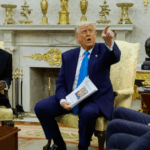Summary by Geopolist | Istanbul Center for Geopolitics:
When Russian tanks rolled across the Ukrainian border in February 2022, the world watched with horror—and Washington responded with action. Within days, the United States, alongside its allies, began implementing one of the most aggressive sanctions campaigns in modern memory. The aim was clear: isolate Russia economically, drain its war chest, and signal to the world that violating a sovereign nation’s borders would not come without consequences.
Over two years later, that campaign has grown into a global effort spanning banking, energy, technology, and trade. And yet, the war continues. Russia’s economy, while strained, is far from broken. With Donald Trump now back in the White House, the U.S. approach is shifting once again—this time toward negotiating a ceasefire, but still wielding the sanctions hammer to press Moscow to the table.
Freezing the Lifelines: Financial Isolation as First Strike
At the heart of the U.S. response was a bold financial strike. In an unprecedented move, Washington froze $5 billion in Russian central bank reserves held on American soil. It wasn’t just about locking down money—it was about sending a message that the United States could and would paralyze an adversary’s economic machinery.
Russian banks were quickly unplugged from SWIFT, the global messaging system that facilitates cross-border payments, and American investors were banned from trading Russian bonds or stocks. Practically overnight, Russia found itself locked out of the global financial marketplace. Sanctions extended all the way to President Vladimir Putin himself and his powerful circle of oligarchs, whose yachts, villas, and offshore accounts became targets.
But Russia wasn’t entirely unprepared. It had been building up over $640 billion in reserves before the war—only half of which were held in Western banks. Even so, the financial blow was sharp and disorienting, setting the tone for a drawn-out economic confrontation.
Turning Off the Taps: Starving Russia’s Energy Revenues
No single sector funds the Russian state like energy. In 2021, oil and gas exports brought in over $240 billion—almost half of Russia’s export earnings. The United States understood this all too well. Just weeks into the war, it banned imports of Russian crude oil, liquified natural gas, and coal. Later that year, it coordinated with the G7 to impose a price cap on Russian oil sold globally—an attempt not just to ban, but to control and limit revenue from sales to countries like China and India.
Then came a quieter but potent move in 2024: a ban on enriched uranium from Russia, which had been a steady source of income and influence over nuclear-dependent countries. Though U.S. firms have until 2028 to fully comply, the message was unmistakable—America was chipping away at every corner of Russia’s energy empire.
Russia adapted, as it often does, by pivoting to other buyers. Energy exports to China and India soared. A “shadow fleet” of aging oil tankers now carries Russian crude across the globe, often without clear documentation or insurance. Still, profits have fallen. The pressure is real, even if not yet fatal.
Disabling the Arsenal: Targeting Military and Tech Ambitions
Modern wars rely on more than bullets—they depend on chips, drones, and precision technology. Recognizing this, the U.S. clamped down on high-tech exports to Russia. Semiconductors, aircraft parts, and software that could be repurposed for war were swiftly blacklisted. Even foreign-made products that use American components were banned.
The effect has been slow but noticeable. Russian airlines are struggling to maintain their fleets. The military is finding it harder to replenish advanced equipment. Yet, the Kremlin has turned to new sources. China has become an indispensable partner, exporting chips and dual-use goods that often fall in a gray area of regulation. It’s a cat-and-mouse game—one that’s far from over.
Beyond Oil and Banks: Cutting Off the Loopholes
As the sanctions regime matured, it began reaching into Russia’s less obvious sources of wealth. One major target? Diamonds. In 2024, the United States and G7 banned imports of Russian diamonds, severing a $4 billion-a-year industry.
Washington also began looking beyond Russia’s borders—to those helping Moscow stay afloat. Companies in Turkey, the UAE, and even China were sanctioned for facilitating trade routes that circumvent Western restrictions. These efforts were meant to close the backdoors, but they also highlighted the challenges of global enforcement in a world where not every nation shares Washington’s strategic goals.
An Uneasy Alliance: Europe’s Reluctant but Critical Role
The U.S. has not acted alone. The European Union has been a crucial partner, though not without tension. When the war broke out, Europe was deeply dependent on Russian energy—40 percent of its gas and one-third of its oil came from Moscow. Despite that, the EU banned most Russian oil by the end of 2022 and imposed further restrictions on refined petroleum products in early 2023.
But gas has remained a sticking point. Some countries, like Hungary, refused to support a full embargo. Even in 2025, Russian gas continues to flow into parts of Europe, albeit in smaller volumes and at higher prices. Nonetheless, the EU has vowed to phase out all Russian gas by 2027—a goal that once seemed unimaginable.
Cracks and Workarounds: Is the Pressure Working?
Sanctions have bitten, but not broken Russia. There are real consequences—shortages of medicine, aircraft parts, and key imports. Yet, the Russian economy has not collapsed. In fact, in 2024, it grew by 3.6%, according to the IMF. That growth, fueled by war spending and redirected trade, tells a complicated story.
This is not a war economy in ruins; it is a war economy reinventing itself. Russia has imposed capital controls, hiked interest rates, and redirected trade toward the East. The ruble has stabilized. Chinese yuan and Russian rubles now dominate bilateral trade between Moscow and Beijing, replacing the U.S. dollar and euro.
To many Western observers, this resilience is frustrating. But some experts argue that the point of sanctions was never an immediate collapse. Rather, it was about building long-term costs and sending a unified message: that invading a neighbor in the 21st century will come at a price, even if that price takes time to exact.
Trump’s Return: Sanctions as Leverage for Peace
With Donald Trump back in office, the U.S. sanctions strategy has entered a new chapter. Rather than dismantle Biden’s policies, Trump has kept the core of the sanctions intact—and dangled the threat of new ones. His goal? A ceasefire.
Since April 2025, the Trump administration has aggressively pushed both Kyiv and Moscow toward peace talks. Trump has warned Russia that failure to agree to a temporary ceasefire will result in a fresh round of punitive measures. European Commission President Ursula von der Leyen has echoed the same sentiment, suggesting that the EU is ready to expand sanctions on Russian energy and finance if talks stall.
In May, Russian and Ukrainian delegations met in Istanbul for their first direct negotiations since the early weeks of the war. The absence of Trump, Putin, and Zelenskyy underscored the fragility of the process—but also the seriousness with which Western governments are trying to restart diplomacy. Whether these talks bear fruit remains to be seen.
Conclusion: A War Measured in Rubles and Resolve
The war in Ukraine has become more than a military conflict—it’s a global contest of endurance, principles, and economics. Sanctions have become a central tool in that struggle, shaping Russia’s economy, forcing new alliances, and testing the cohesion of the West.
They haven’t yet brought peace. They haven’t yet broken the Kremlin. But they have drawn clear red lines. For every ruble lost, for every sanctioned bank, for every grounded aircraft, the message from Washington has remained consistent: aggression carries a cost. And if Donald Trump has his way, that cost may yet rise.
Resd more here.







